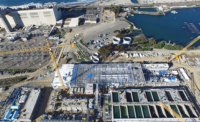About 50 mgd of the diverted seawater will go through anthracite and micro-screen pretreatment, which will extract salt using RO-membrane separation, with 8-in. membranes. The plant will store that 50 mgd of water in an on-site reservoir before pumping it to the water authority's drinking-water system for further treatment and distribution.
Another 54-mgd stream emerging from the RO system will be a brine with twice the salinity of the ocean. It then will be diluted in the powerplant discharge channel for blending with the remaining cooling water before ocean discharge.
The desalination project will require the water authority to spend about $80 million in related construction, Yamada notes. Those jobs include relining a 5-mile-long section of a pipeline to accommodate higher pressures from the plant and modifying the Twin Oaks Valley water treatment plant to blend desalinated water with existing supplies.
A Known Quantity
The RO system will be using proven technologies in place at its existing plants even though the firm has introduced significant innovations, notes IDE CEO Avshalom Felber.
 |
| FELBER |
Felber says the firm's R&D efforts have reduced energy consumption by over 15% "through unique design and technology we've developed."
The Carlsbad plant will incorporate green elements to achieve carbon-neutral status. One feature is a device from Energy Recovery Inc., San Leandro, Calif., that recycles pressurized water energy from the RO trains. Poseidon claims the device will reduce the desalination-process energy footprint by 45%. The plant itself also will have rooftop solar panels to produce about 1 MW of energy, displacing load that normally would be bought off the grid. Providing a local source of drinking water, instead of importing it, will provide additional energy savings, MacLaggan says.
Legal Challenges
Although the authority touts the project's overwhelming public support, some local environmental groups have raised concerns over its location and design. "Trying to use ocean desalination as your first choice for resolving scarcity concerns takes all the investment money that could be spent on more economical and environmentally sound alternatives," says Joe Geever, water-resources manager with Surfrider Foundation, which filed 14 lawsuits during the permitting process. All were dismissed or rejected, the last by a federal appeals court in November 2012.
Geever says the group's argument was undermined because Poseidon obtained temporary, rather than long-term, permits for the plant's life expectancy. He adds that, by 2017, the Encina powerplant will no longer be able to use seawater for cooling under new California regulations.
"Tampa has led to a big trauma, and the consultants and clients were very cautious about the project design," Felber says. The Carlsbad team visited IDE's operating plants in Ashkelon and Hadera, both in Israel, and one in Cyprus. Instead of using 8-in. membranes, the newest plant at Sorek, near Tel Aviv, is using 16-in. membranes, Felber says, which increases water output and reduces energy use. The plant began operation this summer and uses no chemicals in the pretreatment stage, he says.






